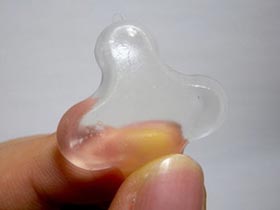New hydrogen material helps treat cleft palate
According to a report by scientists at the Oxford University of England, they have studied a new generation of hydrogen materials that can be used to help treat congenital cleft palate in newborns.
To conduct the treatment of cleft palate, scientists have taken measures to bring new generation hydrogen materials into the mucosa around the frog jaw in the upper jaw of patients.
 Because the new material can absorb liquid, so when it swells, the mucosa also develops. After the hydrogen material swelled and filled the gap, the scientists would perform surgery to remove the material, then use the mucosa to replace the gap.
Because the new material can absorb liquid, so when it swells, the mucosa also develops. After the hydrogen material swelled and filled the gap, the scientists would perform surgery to remove the material, then use the mucosa to replace the gap.
Hydrogen materials look like materials for contact lenses. Its biggest feature is that after absorbing the liquid, it will not expand freely, but it can be controlled to expand in the direction of covering the frog, thereby avoiding the development of the mucosa.
The new materials will bring happiness to many patients, the executive director of the British Open-Mouth Treatment Association said. Scientists are very hopeful about the results of clinical trials in the near future.
Cleft palate is a relatively common congenital deficiency. The usual treatment is surgery to adjust the upper jaw mucosa to attach the gap. However, if the jaw is too wide, insufficient mucosal volume will make surgery difficult.
- VN: nearly 2,000 newborn babies suffer from cleft lip and palate every year
- Folic acid may help prevent cleft lip and cleft palate
- US made the most precious and valuable materials in the world
- Autralia welcomed the first 2-sided cat
- Detection of the protein that causes palate cancer
- Identify 5 genes that regulate face shapes
- Producing hydrogen from water and sunlight
- Cell phone powered by ... hydrogen
- Find an extremely effective, surprisingly cheap hydrogen extraction method
- Road-driven cars: the world's most efficient method of hydrogen production
- Tooth bone tumors cause many people to fear cancer
- Applying hydrogen storage technology to vehicle production
 Green tea cleans teeth better than mouthwash?
Green tea cleans teeth better than mouthwash? Death kiss: This is why you should not let anyone kiss your baby's lips
Death kiss: This is why you should not let anyone kiss your baby's lips What is salmonellosis?
What is salmonellosis? Caution should be exercised when using aloe vera through eating and drinking
Caution should be exercised when using aloe vera through eating and drinking